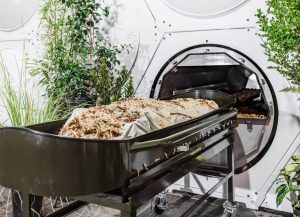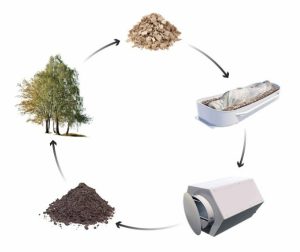Posted on December 27, 2022 by Marla E. Wieder
New York State is on the verge of legalizing human composting. The bill (Assembly Bill A382 and the Senate version, Senate Bill S5535) overwhelmingly passed the Assembly (61 aye/2 nay) and Senate (64 aye/2 nay). It is awaiting signature by Governor Kathy Hochul.
Specifically, the bill would amend New York State’s not-for-profit corporation law, to define and establish the process of human composting (‘natural organic reduction’) and the responsibilities of natural organic reduction facilities. When the bill is signed into law, New York will become only the 6th state to allow the practice. Washington State was the first state to legalize human composting in 2019, followed by Colorado (2021), Oregon (2021), and then Vermont (2022). Earlier this year California became the most recent state to approve a human composting bill, although it’s not set to go into effect until 2027.
While the ‘experience/process’ is new, let’s not lose sight of the fact that for all intents and purposes the practice is as old as dirt. Yes, pun intended.
Natural organic reduction – also known as ‘terramation’ — involves placing a dead body in a reusable vessel with biodegradable materials such as wood chips and straw, that aid in its transformation into nutrient-rich soil. In a mere thirty days and about $7,000 later, your loved one transforms into approximately one cubic yard of ‘soil amendment.’ After being allowed to ‘cure’ for several weeks and after the bones are removed and processed, your loved one can be used in gardens, planted with a tree, donated to a land trust, or returned to the earth however you please.
I know what you’re thinking – – $7,000 seems like a lot to pay for potting soil, even in Manhattan. After weighing various traditional and non-traditional end-of-life options, and even taking into account my failed personal composting endeavors in upstate New York (queue the bears), I’m all in.
While it’s challenging to compare the economics, the costs of natural organic reduction are on par with traditional burials in metropolitan areas but are less economical than cremations. However, costs should decrease over time with wider acceptance and additional terramation facilities. According to Funeralocity, a traditional full-service funeral will set you back over $5,000 in the U.S., exclusive of cemetery fees. However, the costs will far exceed that in certain metropolitan areas and the sky is the limit on price depending upon services and options. “Affordable burials” average about $3,000. “Direct cremations” are available for under $2,000.
Beneficial Reuse Project
Approximately 2.7 million people die in the U.S. each year and the vast majority are buried in a conventional cemetery or cremated, with cremation having a slight lead over burial. Dozens of materials and processes are involved in both options, which makes the environmental impact of both methods far more significant than composting.
Current funerary practices, which usually include embalming or injecting a corpse with about 3 gallons of chemicals to preserve it for extended viewing, have changed little in the past century. While greener options are now available, typically embalming fluid is comprised of a mix of chemicals, including benzene, methanol, ethyl alcohol, and ethylene glycol (antifreeze). Formaldehyde, which constitutes anywhere from 5 to nearly 30% of the solution, is classified as a ‘probable human carcinogen’ and is associated with increased risk of ALS (Amyotrophic Lateral Sclerosis), leukemia, lymph hematopoietic malignancies, and brain cancer in embalmers. Aside from the annual addition of approximately 16 million liters of embalming fluid to land, about 47,000 cubic meters of wood is used for coffins, and a significant amount of energy and raw materials are used to manufacture burial vaults and monuments.
While the cremation process burns fossil fuels and emits carbon dioxide and particulates into the atmosphere, the environmental impact of cremation versus burial is arguably about the same. By some estimates, a single cremation puts about 190 kilograms of carbon dioxide into the air, which is the equivalent of driving 470 miles in a car. While that is about twice the amount of CO2 as a ground burial, looking at the entirety of the process, some studies have concluded that conventional burials have a greater environmental impact than cremation when you factor in ‘land use’ considerations such as the energy and resources needed to maintain cemetery lawns.
In contrast, human composting requires 1/8 the energy of conventional burial or cremation. For every person who chooses a composting option, one metric ton of carbon dioxide is prevented from entering the atmosphere. In addition to what is being saved, what is being created is nutrient rich soil, the foundation of a healthy ecosystem.
Given the environmental, economic, and growing land-use pressures, I fully expect that we will start to see more states legalize natural organic reduction as an end-of-life option. In time, and once people fully understand the process, I hope that it could become more mainstream, if not the default means to return us to the dust from which we were made.


